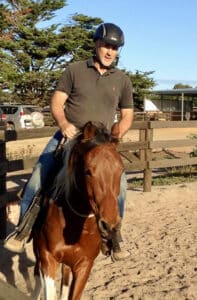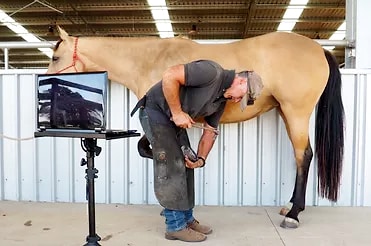Wayne Turner has worked in the horse industry for the last 30 years. He’s the founding partner of Progressive Equine Services & Hoof Care Centre, and is dedicated to a modern approach to farriering.
Q: Where are you based?
A: Warragul, Victoria.
Q: When did your interest in horses begin?
A: I have always had an affinity for horses since growing up on a farm, but didn’t really get involved with them until my mid-twenties.
Q: What did you want to be when you were growing up?
A: A professional golfer.
Q: Did you participate in any horse sports?
A: I did some endurance riding, but as competitive as I am personally, I’ve never pushed that onto my horses.
Q: When did you become involved in farriering?
A: In my early ‘30s.
Q: What other interests do you have?
A: I’ve been very sporty all my life and competed in a few professional triathlete races. I still ride my bike and play a bit of golf, but nothing serious these days as I’m busy running Progressive Equine Services & Hoof Care Centre (PES). We also started a lot of horses under saddle for many years, which allowed me to work overseas a bit.
Q: Where have you worked overseas?
A: When I was starting horses I spent time in India, UAE, the UK and Europe.
Q: When you started farriering did you shoe in the traditional way?
A: Yes, but I had a great teacher who believed we didn’t have all the answers and this has kept me searching. The open heel metal shoe was developed for protection of the foot only and it does that extremely well. Originally horses were shod so armies could travel further, before the horses became foot sore. Back then, shoeing had little to do with supporting ideal foot function, or meeting the needs of the foot, and sadly not much has changed.
Q: What led to the establishment of PES?
A: I saw just how many horses were suffering from poor farriery and felt there must be a better way. The direction I took was to try and gather more accurate and objective data, which is why I got licensed to own and operate x-ray equipment. It’s the best decision I ever made, and we’ve helped thousands of horses over the last eight years. PES also works with other farriers, both in Australia and overseas. We are more than happy to take x-rays or gather data for colleagues, answer any questions, and help them as much or as little as they want in order to achieve the best result for each horse.
Q: How does PES differ to other farriering businesses?
A: We use modern technologies including gait analysis and x-ray equipment, and Werkman Black, an innovative technology that gathers objective data on every facet of your horse, which allows us to determine the horse’s needs more objectively and trim and shoe them accordingly. This is a long way from most other farrier businesses, which often use subjective opinion and guesswork for much of the evaluation, trimming and shoeing process.
Q: Which country is the most advanced in farriering?
A: I would say the UK sets the standard, but I don’t see any country moving in the right direction. The use of modern technologies to better evaluate a horse’s needs must be incorporated into farrier training and practices if we’re to move forwards. With a few exceptions, we’re still shoeing horses as we did several hundred years ago. Sadly, there’s still so much resistance in the industry to move into the modern era, which negatively impacts the horse, their comfort, soundness, and performance!
Q: Have you written a book?
A: In 2003 I authored a book on optimising breakover efficiency for a shoe idea we developed.
Q: In your opinion, what’s in the best hoof dressing?
A: I don’t advocate for most hoof dressings. Good nutrition, stimulation, loading, movement, and hoof care are what’s best for horses’ hooves. I think walking them into water over their fetlocks every day or two is a great idea through the drier months.
Q: Are there some breeds or types you don’t or won’t shoe?
A: I’ll happily work with any horse that will stand quietly to be shod. Breed and discipline are irrelevant, but my safety is paramount.
Q: Do you shoe elite competition horses?
A: We shoe top level horses from most disciplines, yes. But we also shoe many Pony Club, riding club and trail riding horses too. To us, each horse is of equal value, from Olympic through to Pony Club horses.
Q: Do other farriers contact you for advice?
A: It’s amazing how many farriers contact us from all around the world. Many did not like what we had to say several years ago in relation to open heel shoes, caudal failure and trimming styles. But they’ve seen our results over many years, and we’re still saying the same things. It’s great when they send photos or messages showing the changes they’re making by following our work and shoeing style.

Wayne has always had an affinity with horses.
Q: You have an extensive online following. A: We have almost 40,000 followers on our PES Facebook page, and we post most days, often with our thoughts on various aspects of farriery. We show a lot of before and after photos on hoof corrections, we also show x-rays and data reports from the equipment we use, so our followers can better understand the internal and external foot. My goal for my social media page was for owner education, but we have a huge following of hoof care providers, trainers, vets and other people working in the industry from around the world.
Q: Are there many female farriers?
A: Yes, there are many in this country and internationally, and many are also exceptionally good.
Q: Do you have a family?
A: Just me and Wilson, the Staffordshire terrier.
Q: Do you have time for a social life?
A: Sorry, I don’t understand the question!
Visit Progressive Equine Services or email info@progressiveequine.com.au for more information.
5 Extra Questions
Q: When it comes to shoeing in Australia are there fads and fashions? Horses going barefoot seems to have grown in popularity.
A: Open-heel metal shoes are still the most used shoe world-wide. Sadly, this shoe contributes significantly to caudal failure, which is the biggest issue we have in horses’ feet globally (as much as 87% of all horses we have evaluated). We’ve been part of the change to using shoes with caudal support, and have been getting fantastic results with both prevention and correction of caudal failure. What’s pleasing is that whilst we came under immense criticism from the industry initially, these days so many farriers around the world are now following our lead by using caudal support, and they’re getting the same impressive results.
Many people turn to barefoot due to the negative effects of caudal failure and distortions created by open heel shoes. But we’re seeing much improvement in farriery with the use of caudal support, and in several areas we’re correcting feet faster than barefoot. But I think the debate over which is better, shoes or barefoot, is ridiculous and I don’t tolerate it on my FB page. We promote good hoof care, be it using shoes or barefoot trimming, because every horse and owner’s hoof care needs are different.
Q: Elaborate on your FB content.
A: Many of the FB posts on Progressive Equine Services and Hoof Care Centre (PES) are our thoughts on various aspects of farriery. We show a lot of before and after photos on hoof corrections, we also show data reports from the equipment we use and a lot of x-rays and photos so our followers can better understand the internal and external foot. My goal for my social media page was of owner education, but we have a huge number of hoof care providers, trainers, vets and other people who work in the industry from around the world also following us.

To ensure the best outcome for the horse, Wayne uses x-rays and other data gathering technologies.
Q: Has the syllabus for apprentice farriers in Australia changed over the years?
A: Sadly, whilst some areas have changed slightly, we’re essentially teaching the same thing we did hundreds of years ago and it must change. In my opinion there’s still too much focus on shoe making and not enough on understanding what is most important to the horse and the farrier i.e. trimming and better understanding the foot, conformation, equine biomechanics and so on. This is even more so today with so many great machine-made shoes available.
We discuss the fact that apprentices learn to make a plain stamped open heel metal shoe, then advance to making fullered open heel shoes. From then on, they learn to make several remedial shoes that are needed to correct the damage to horses’ feet caused by the open heel metal shoes they were initially taught to make! I’m not blaming anyone, but we just need to move forward and better understand and teach the needs of horses and their feet, and peripheral loading from open heel shoes are not it.
Q: Your greatest success story?
A: I had this discussion a month or so ago with another farrier in WA. He asked how I measure success, as a vet had asked him the same thing. PES is a comfort first hoof care provider and I judge my success on how much comfort I can create for each horse. We’re often the last port of call for many horses with problems and often the owners have tried everyone and everything else before us. But in most cases, through detailed evaluation and an understanding of the need for comfort first, we get results that others say are not possible, that the horse should be retired and so on. We recently worked on a ripping Appaloosa gelding that had been in such discomfort for the last four years euthanasia was being considered.
Again, we were the last option. After six weeks with us he is back being ridden. The owner, vet and physio cannot believe the change in this horse in such a brief time. His posture, demeanour, movement, and behaviours have all altered dramatically and it’s largely to do with his improved comfort level. Whilst horses still have a job to do, my experience, and we prove it time and again, is that they do it much better when they’re comfortable and not in pain.
Q: What does a regular day look like for you?
A: Normal is an interesting word! We shoe horses most days and every Monday we work at the vet clinic, but there’s also the business side of PES and my FB page, which take up much of my time. Chris Diedericks, DipWCF (Diploma of the Worshipful Company of Farriers), has now started with PES and is doing some magnificent work. He is arguably the best farrier in Australia so this is giving me more time to work on other areas of the business.
We are about to start an educational video series on farriery, which will incorporate all the technologies we have at our disposal. We will be detailing every aspect of our work from assessment, both pre- and post-shoeing, right through the trimming and shoeing process, and showing all the products we use and recommend in detail. We have just spent $20,000 on equipment so that we can give those interested the best quality video and audio possible, including some interesting drone footage. So, to answer the question, there is not a lot of normal in my week!
Feature Image: After upgrading his audiovisual equipment, Wayne is producing an educational video series on farriery.



